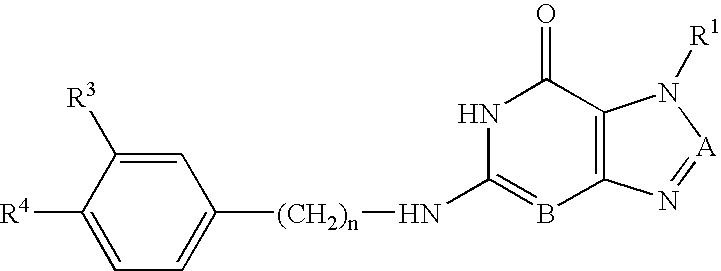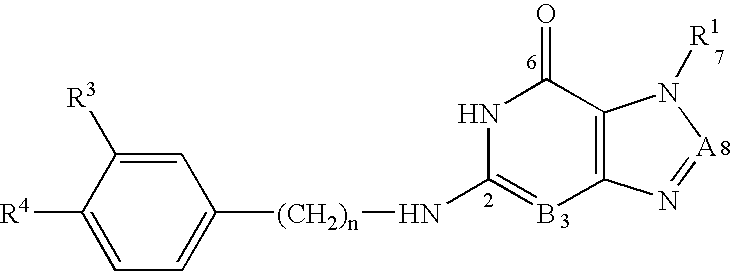Purine and isosteric antibacterial compounds
a technology of isosteric antibacterial compounds and purine, which is applied in the field of purine and isosteric antibacterial compounds, can solve the problems of serious and potentially life-threatening diseases the rapid growth of the global crisis in the clinical management of life-threatening infectious diseases, and the threat to public health of gram-positive and gram-negative pathogens. to achieve the effect of reducing the likelihood of such an infection, reducing the likelihood of gram-
- Summary
- Abstract
- Description
- Claims
- Application Information
AI Technical Summary
Benefits of technology
Problems solved by technology
Method used
Image
Examples
example 1
Enzyme Assays and Determination of Inhibitor Ki Values
[0237]DNA pol III activity was assayed as described in Barnes et al., Nucl. Acids Res. 1979, 6, 1203-1219, using activated “nicked” calf-thymus DNA as template:primer, 10 pM [3H-methyl]-dTTP as the labelled dNTP substrate, and dATP, dCTP, and dGTP at 25 μM each.
[0238]Inhibitory activity of the compounds was determined by measuring the ability of the agent to inhibit enzyme-catalyzed incorporation of [3H]-dTMP into nicked calf thymus DNA in the absence of the competitor dGTP (“truncated assay”, see Wright and Brown, Biochim. Biophys. Acta 1976, 432, 37-48). Purified pol IIIC or pol IIIE was added to a buffered solution containing Mg2+, DTT, glycerol, nicked calf thymus DNA, saturating concentrations of dATP, dCTP, dTTP and [3H]-dTTP. Reaction mixtures were incubated at 30° C. for 10 min, quenched and filtered, and radioactivity in the acid-insoluble material measured by scintillation counting. Experiments were done in triplicate. ...
example 2
Inhibition of Bacterial Growth and Determination of Minimum Inhibitory Concentration (MIC) Values
[0239]Each compound was assayed against a panel of Gram-positive Bacilli, Enterococci, and Staphylococci, and Gram-negative Escherichia coli, grown in appropriate plate media solidified with 1.3% agar-agar. Stock solutions of the compounds in DMSO or water, depending on solubility, were added to sterile medium at a temperature of 60° C. This stock mixture was diluted with drug-free medium and used to make a series of Petri plates containing inhibitor in a series of two-fold serial dilutions, from about 80 to 0.0625 μg / mL. One tenth mL of diluted bacteria containing 500-1000 colony-forming units (CFU) were plated and spread, and the plates were incubated at 37° C. for 24 hours. MIC (minimum inhibitory concentration) was equivalent to the lowest concentration at which growth, i.e. colony formation, was not observed. The typical range of MIC values for compounds of the invention was 0.1-40 ...
example 3
[0240]Table 1 summarizes the DNA polymerase inhibition and antimicrobial activity of representative compounds of the invention. The compounds are highly active DNA polymerase inhibitors and have antimicrobial activity. The phenylamino compounds also selectively inhibit pol IIIC, while the benzylamino compounds inhibit both pol IIIC and pol IIIE.
PUM
| Property | Measurement | Unit |
|---|---|---|
| Speed | aaaaa | aaaaa |
| Speed | aaaaa | aaaaa |
| Speed | aaaaa | aaaaa |
Abstract
Description
Claims
Application Information
 Login to View More
Login to View More - R&D
- Intellectual Property
- Life Sciences
- Materials
- Tech Scout
- Unparalleled Data Quality
- Higher Quality Content
- 60% Fewer Hallucinations
Browse by: Latest US Patents, China's latest patents, Technical Efficacy Thesaurus, Application Domain, Technology Topic, Popular Technical Reports.
© 2025 PatSnap. All rights reserved.Legal|Privacy policy|Modern Slavery Act Transparency Statement|Sitemap|About US| Contact US: help@patsnap.com



